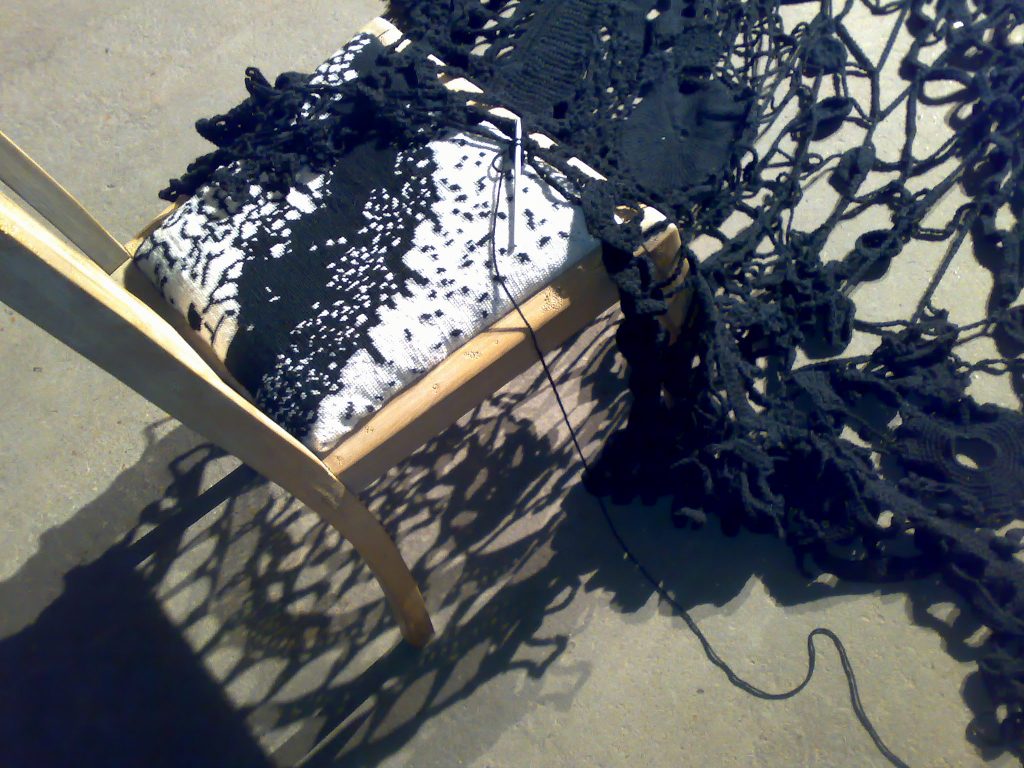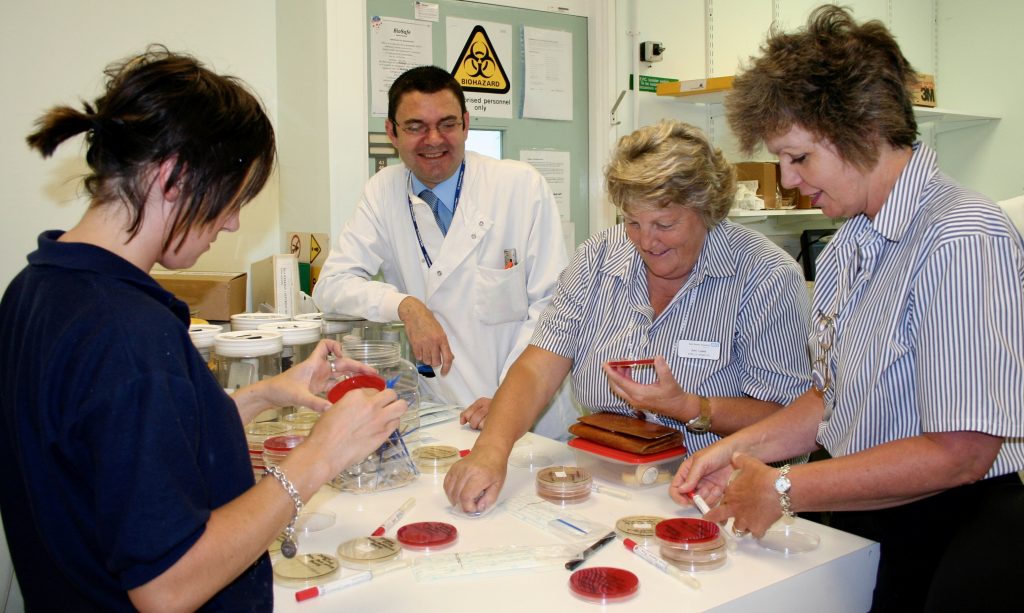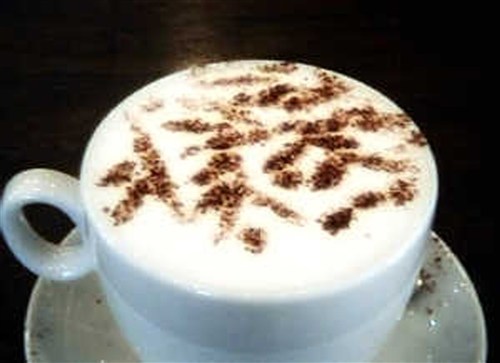Anna Dumitriu’s “Normal Flora” project began in 2004 as a pioneering artistic project created in collaboration with microbiologist Professor John Paul. It significantly pre-dates contemporary popular research into what has become known as “the microbiome”, a field made possible through developments in new technologies in genomics. When the project began this area of microbiological study was actually considered to be of no commercial or medical interest, and so the project threw into question the ways in which our scientific understanding of the world is limited by finance, and how the limits of our understanding are drawn.
The project offers a physical embodiment of the interconnectedness of life through a deep examination of the rarely noticed everyday world of microbial life: the bacteria, moulds and yeasts that surround us and live both on and inside our bodies through the creation of an (ongoing) series of artworks, participatory performances and workshops.
“Normal flora” microbiology was the previous name given to the study of the ubiquitous bacteria, moulds and yeasts that form an absolutely key part of the complex ecosystems we live constantly with: our bodies, our homes and our everyday world, and, of course, the wider planet. We are so closely linked to these minute life-forms that it is worth considering for a moment that more bacteria can be found on the end of an average fingertip than there are people actually living in the world; and several kilograms of our body weight are made up of bacterial symbionts. But these facts are not widely known. The word ‘bacterial’ is synonymous with dirt; the normal reaction to the suggestion that something is covered with bacteria is one of disgust but in fact less than 1% of bacteria are harmful to us and many are actually beneficial.
Key to developing the work and influencing all Dumitriu’s process ever since involved Professor Paul’s insistence that she be trained in microbiology and do all the experiments herself following proper procedures and fully documenting all the work and results in a lab book but artistic reflections given as much weight as scientific results. Much of the work involves participatory elements and Dumitriu and Paul worked together to develop DIY microbiology activities that could be done safely with the public, such as in the later “Infective Textiles” project. Dumitriu and Paul’s collaboration then evolved into Dumitriu’s role with the Modernising Medical Microbiology project which focussed on infectious diseases and the uses of new technologies for dealing with them, such as her ongoing “Romantic Disease” project on tuberculosis and her work with Dr Nicola Fawcett (Oxford), Dr Caroline Chilton (Leeds) and Dr Jane Freeman (Leeds) on the gut microbiome and the impact of antibiotic resistance.
The project was featured in “Intimacy Across Visceral and Digital Performance” in a chapter by Anna Dumitriu “Normal Flora: Intimate Revelations in Art and Science“, published by Palgrave McMillan, Edited by Maria Chatzichristodoulou and Rachel Zerihan.
Discussions on the project were featured in the feminist art journal n.paradoxa, vol. 20: Translate/Narrate (July 2007): 5-12, in “Normal Flora and the Bacterial Sublime: An Interview with Anna Dumitriu” by Alexandra Kokoli.
List of Works
Bed and Chair Flora

“Bed and Chair Flora” (2004-5) comprises an altered found chair and a crocheted bed cover. The chair has been carved and re-upholstered with a needlepointed cover. The images represent bacteria that Dumitriu cultured from the found object. The ongoing collaborative crochet is based on transmission electron microscope images of bacteria from the artist’s own bed and many wonderful crocheters who have added to the work each time it has been exhibited. The ongoing ‘growth’ of the crochet mirrors the growth of bacteria, fed by wool, metabolised by crocheters in the ecosystem of the gallery. The project was funded by Arts Council England and has been exhibited at venues including The Rockefeller Arts Centre at the State University of New York (USA), the Blyth Gallery at Imperial College in London (UK), and at Art Laboratory Berlin (Germany).
Cutlery Flora

“Cutlery Flora” (2004-5) is a set of knives, forks and spoons which are laser engraved with images of the bacteria that Dumitriu cultured from clean cutlery in her kitchen drawer and represent clearly the ubiquitous of bacteria and how that contradicts the popular notion that it means unclean. The cutlery is useable.
Lab Coat Flora

“Lab Coat Flora” (2005) is a hand stitched lab coat whitework embroidered with images of the bacteria and moulds that were cultured from it. Around the time of the enlightenment the perversely difficult practice of whitework embroidery was considered to be one of the highest levels of achievement for a woman. They would sew in the evenings by candlelight straining their eyes to see the tiny stitches, hunched over their embroidery hoops, their bodies twisted and constricted by tight corsetry, one pinprick of blood meaning the whole piece would be ruined. This coincided with the period in which many of their male counterparts started to become ‘gentleman scientists’ beginning to rigorously study the world around them ‘scientifically’. This was the time when the scientific method was developed and disciplinary boundaries were drawn between art and science. By juxtaposing whitework embroidery with her scientific practice Dumitriu considers these paradigmatic changes in the process of research and current moves towards transdisciplinarity, alongside a consideration of what ‘feminine’ approaches to science might mean.
Hospital Flora

The Hospital Flora Project took place in 2006 and culminated in February 2007 and involved workshops with hospital staff at Eastbourne District General Hospital, bringing together the microbiology department and the cleaning staff to share knowledge around infection control. Dumitriu also created a new permanent work for the hospital featuring the actual microscope slides of the normal flora microbes cultured during the project, which are presented with digital prints on silk and drawings. The microscope slides appear as brightly coloured pieces of stained glass, or tiny abstract paintings; alongside are digital prints of some of the normal flora cultured by members of hospital staff who participated in the project. An exhibition of Dumitriu’s etchings and drawings of normal flora was held in the adjoining Radiology Waiting Room and a one day participatory event and musical performance of a live string quartet playing the ID (API) codes of the bacteria swabbed from their own instruments took place for visitors and patients.
School Flora

The School Flora project was a collaboration with gifted and talented science students at Varndean School, Brighton UK, commissioned by Brighton and Hove City Council. This project began in July 2007. The students produced artworks based on the laboratory findings of bacteria, moulds and yeasts collected all over the school, from the drinking fountain to the books in the library. The artworks were displayed at the private view on the 15th July 2008 when the entire school became a conceptual artwork, featuring their installations, interventions and performances.
Phone Flora

“Phone Flora” (2005) was a pioneering mobile phone artwork by Anna Dumitriu. It comprised a mobile phone ring-tone and phone wallpaper generated from the bacteria found on the artist’s own mobile phone and made available for online download via a specialist platform (as it was not possible in that time to add a photo as a phone wallpaper). The artwork utilised WAP 2.0 (a precursor to contemporary mobile Internet). The monophonic ringtone was generated from the analytic profile index (API) codes (a method of identification) from bacteria cultured from the phone. The piece was originally exhibited at the Arena Gallery in Liverpool, and subsequently at FutureSonic (now called FutureEverything Festival) in Manchester in 2006. The groundbreaking artwork was also featured by the BBC in 2005.
Bio-tracking

“Bio-tracking” was a pioneering locative media project by Anna Dumitriu that took place in 2006. It combined GPS (Global Positioning System) data and an innovative smartphone software suitable for Nokia Series 60 called Socialight which ran on the Symbian operating system and enabled the placement of virtual ‘sticky notes’ around various locations as part of a walk.
The work was show as part of Brighton Photo Biennial Fringe. As participants walked around the route, artworks, text messages and sound files appeared automatically to their phones.
Anna Dumitriu sampled and cultured various locations for normal flora bacteria and moulds, revealing this incredible, unseen and sublime world to us through a series of beautifully enhanced digital micrographs. She collaborated with sound artists Luciana Haill, Ian Helliwell, Juliet Kac and Dumitriu to create a series of sonic artworks to accompany the images, generated from EEG, musical scores drawn over micrographs, and generated from API codes. Professor John Paul wrote scientific text messages about the microbes that accompanied the images.
The images created a kind of dialectic, bringing together the pure emotion of the sound responses and the analytical texts. Philosopher’s such as Schopenhauer have written much on music’s ability to capture and express emotion “as an immediate objectification and copy of the whole will as the world itself”. The project was featured in the 2008 Mobile Music Workshop and their subsequent book.
By bringing in the use of GPS in the initial creation of the work, mapping the locations where the microbiological swabs were taken, the work draws together the microscopic and the macroscopic, drawing a thread between the satellites orbiting the earth and the bacteria at our feet. The project was also featured in an interview with Regine Debatty for We Make Money Not Art in June 2007 and on Wired in August 2007.
“Pavilion Flora” was also used by Brighton and Hove City Council as one of a series of ‘alternative postcards for the city’.
Food Flora

Anna Dumitriu also created a series of interventions involving food working with the food safety lab in Brighton. Dumitriu cultured samples of fresh food on agar to reveal the harmless bacterial flora which is always present She then altered and decorated the food to reveal images of the bacterial flora on it. In 2006 she performed this work as part of the major launch event for Brighton Food Festival at Brighton Marina.
Coffee Shop Intervention


In 2007 Anna Dumitriu was commissioned Axisweb to make the video artwork “Coffee Shop Intervention” which revealed the microbial flora of chocolate on a cappuccino coffee through a performative action. The piece involved culturing the microbes from the chocolate that would be sprinkled on a frothed milk in a coffee shop, making a stencil from microscope images of those microbes, enticing a barista to use that stencil to reveal the microbial flora on the cappuccino, and then consuming the drink. Made in collaboration with Professor John Paul.
